Trapania cf. brunnea
Rudman, 1987
Order: NUDIBRANCHIA
Suborder: DORIDINA
Superfamily: ANADORIDOIDEA
Family: Goniodorididae
Note added 12 March 2008: Many of the messages on this page refer to a recently named species Trapania euryeia and these have been transferred to that Fact Sheet. I have retained a few here which may or may not be colour forms of either T. euryeia or Trapania brunnea.
Authorship detailsRudman, W.B., 2008 (March 12) Trapania cf. brunnea Rudman, 1987. [In] Sea Slug Forum. Australian Museum, Sydney. Available from http://www.seaslugforum.net/find/trapcfbrun
Related messages
Trapania cf. brunnea in southern Queensland Australia
July 21, 2006
From: Gary Cobb
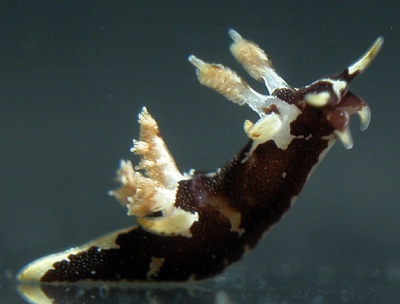
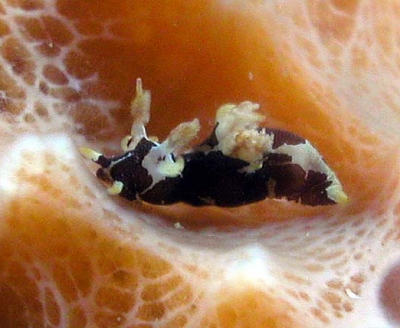
Hi Bill!
Please find attached photos of what can be either Trapania brunnea or T. benni. There were two animals found on an orange-pink sponge. Can you please tell me which one it is and whether it is a new record for southern Queensland.
Locality: Mooloolaba Sunshine Coast, 18 m, Queensland Australia, Pacific Ocean, 08 April 2006, Subtidal. Length: 7 mm. Photographer: Gary Cobb
There appears to be a flap in front of the gills, is this true?
Thanks
Gary Cobb
gary@nudibranch.com.au
Cobb, G., 2006 (Jul 21) Trapania cf. brunnea in southern Queensland Australia. [Message in] Sea Slug Forum. Australian Museum, Sydney. Available from http://www.seaslugforum.net/find/16316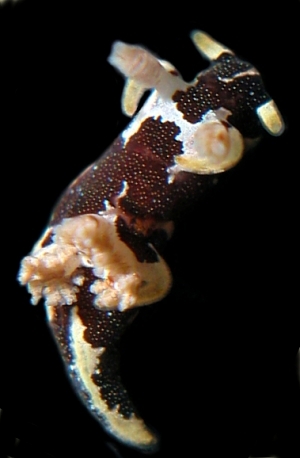
Dear Gary,
This is the species which I discuss in Julie Marshall's message from Heron Island [#4120]. As I discuss there, it has features of the colour pattern of both the species you mention. It's most probably a form of T. brunnea but I think we need to look at its radular teeth to be sure. Neither of the named species have the white patch behind the gills extending back to the tip of the 'tail'.
I am pretty sure the apparent flap in front of the gills is just an extension of the colour pattern up onto the gills. These dorids do not have a branchial sac into which the gills can contract, so usually the gills arise directly from the skin of the mantle. Anything is possible, but I have looked at quite a few specimens of Trapania, alive and preserved, and have never found a flap. The presence of these animals on a sponge is not a random occurrence. Species of Trapania feed not on these sponges however, but on small stalked animals called Entoprocta [= kamptozoa, camptozoa] which are often found living on these sponges [see message #3767 ].
Best wishes,
Bill Rudman
Trapania brunnea? from Heron Island
April 9, 2001
From: Julie Marshall
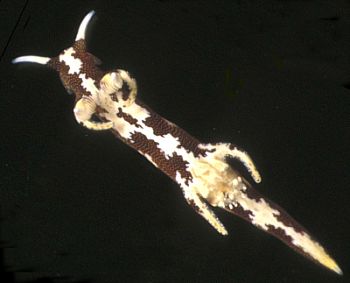
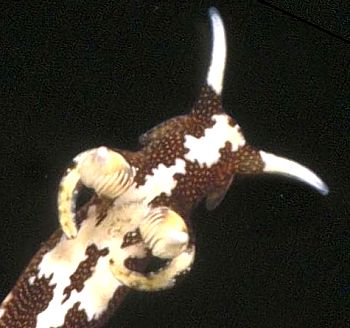
Dear Bill,
I recently found what I think is Trapania brunnea at Heron Island which extends the range of this species in Australia. The pictured animal was 8mm in size and was found at the reef crest under a dead coral slab on 12th March 2001 at low tide.
Best wishes,
Julie Marshall
j.marshall@latrobe.edu.au
Marshall, J., 2001 (Apr 9) Trapania brunnea? from Heron Island. [Message in] Sea Slug Forum. Australian Museum, Sydney. Available from http://www.seaslugforum.net/find/4120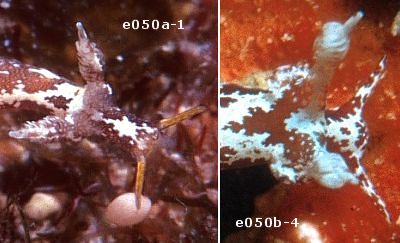
Dear Julie,
I have my doubts about whether your animal is Trapania brunnea. T. brunnea has a uniform dark brown background colour and the midregion of the lateral processes are also dark brown. There is also no sign of yellow in the white patches. Your animal has diffuse yellow markings in the white regions and has small pale spots all over the brown regions. It therefore has similarities to Trapania benni which has small yellow or white spots all over the body and yellow spots in the white patches, althpugh in T. benni the yellow spots are very distinctive.
Looking again at the photos Scott Johnson sent of some other 'potential' T. brunnea which I have temporarily placed on a Trapania cf. brunnea page it seems there may be a group of similarly coloured species or else there is considerable colour variation. I have included here enlargements of the heads of two of Scott's animals showing that the one on the right [e050b-4] has a uniform brown background but the one on the left [e050a-1] has a pattern of small spots like in your animal but has yellow oral tentacles which are indeed unusual. It seems there are still a few things to sort out amongst these brown species of Trapania so I am also putting your animal on the Trapania cf. brunnea page as well, so we don't forget about them.
Best wishes,
Bill Rudman
